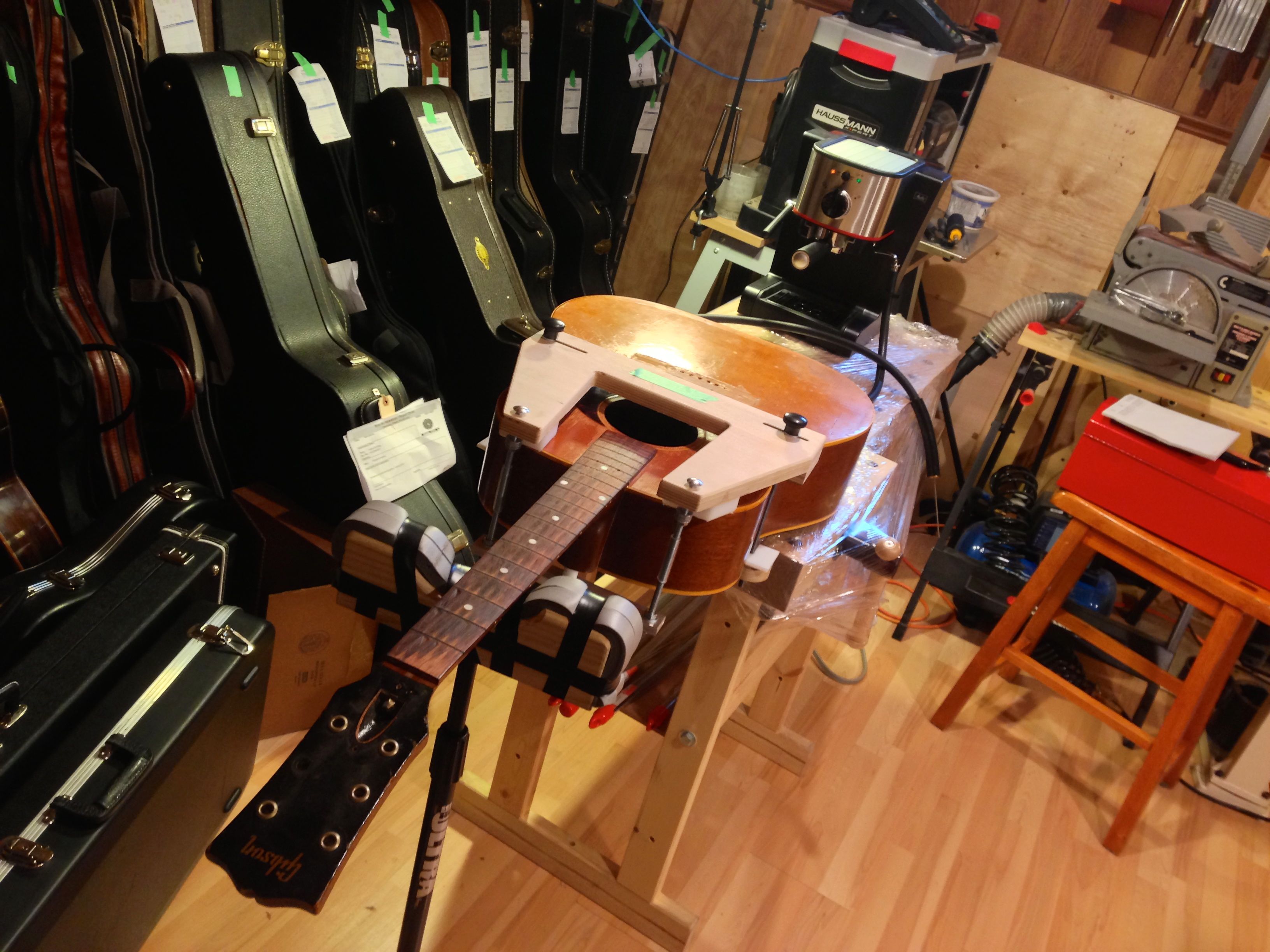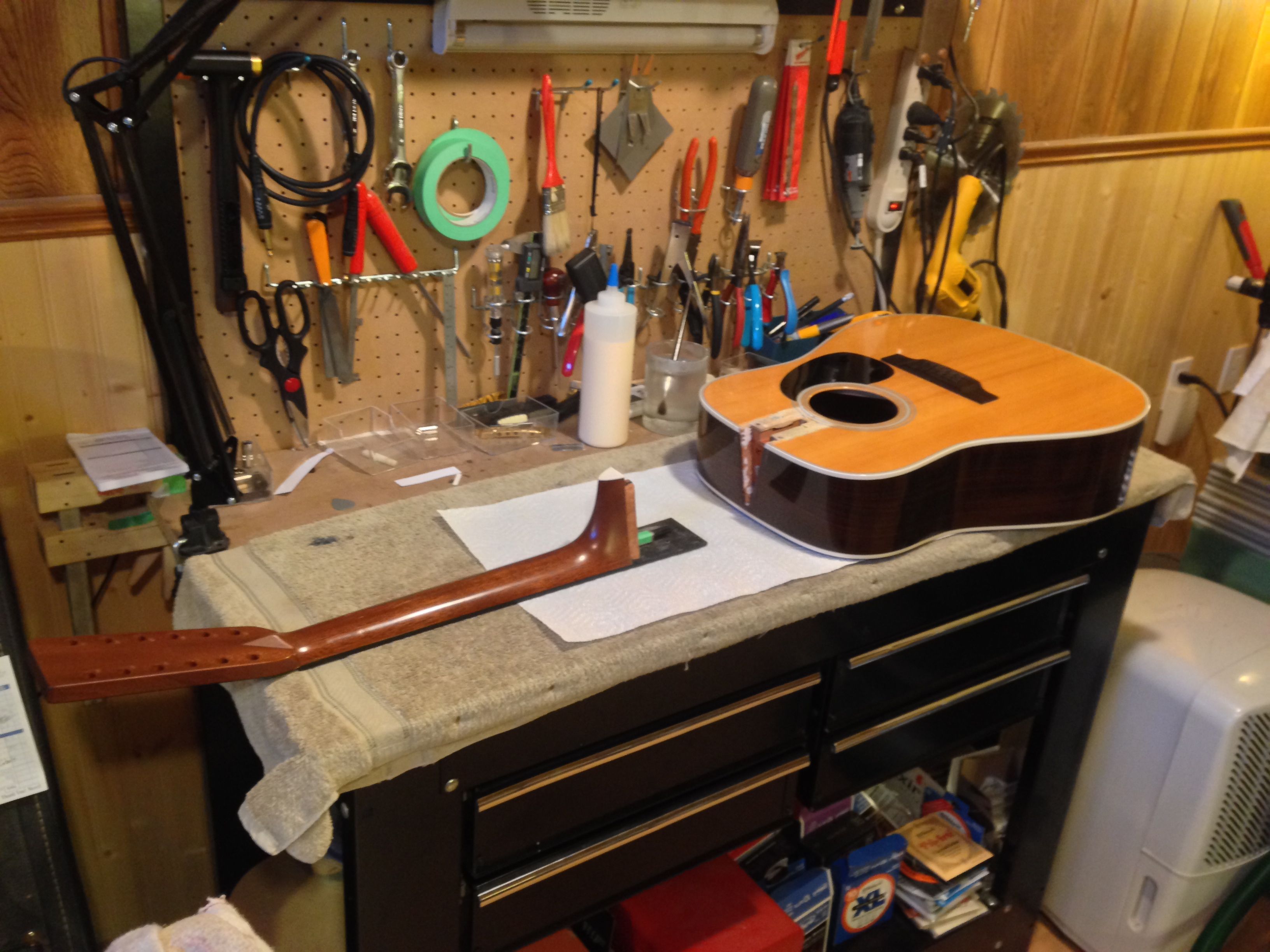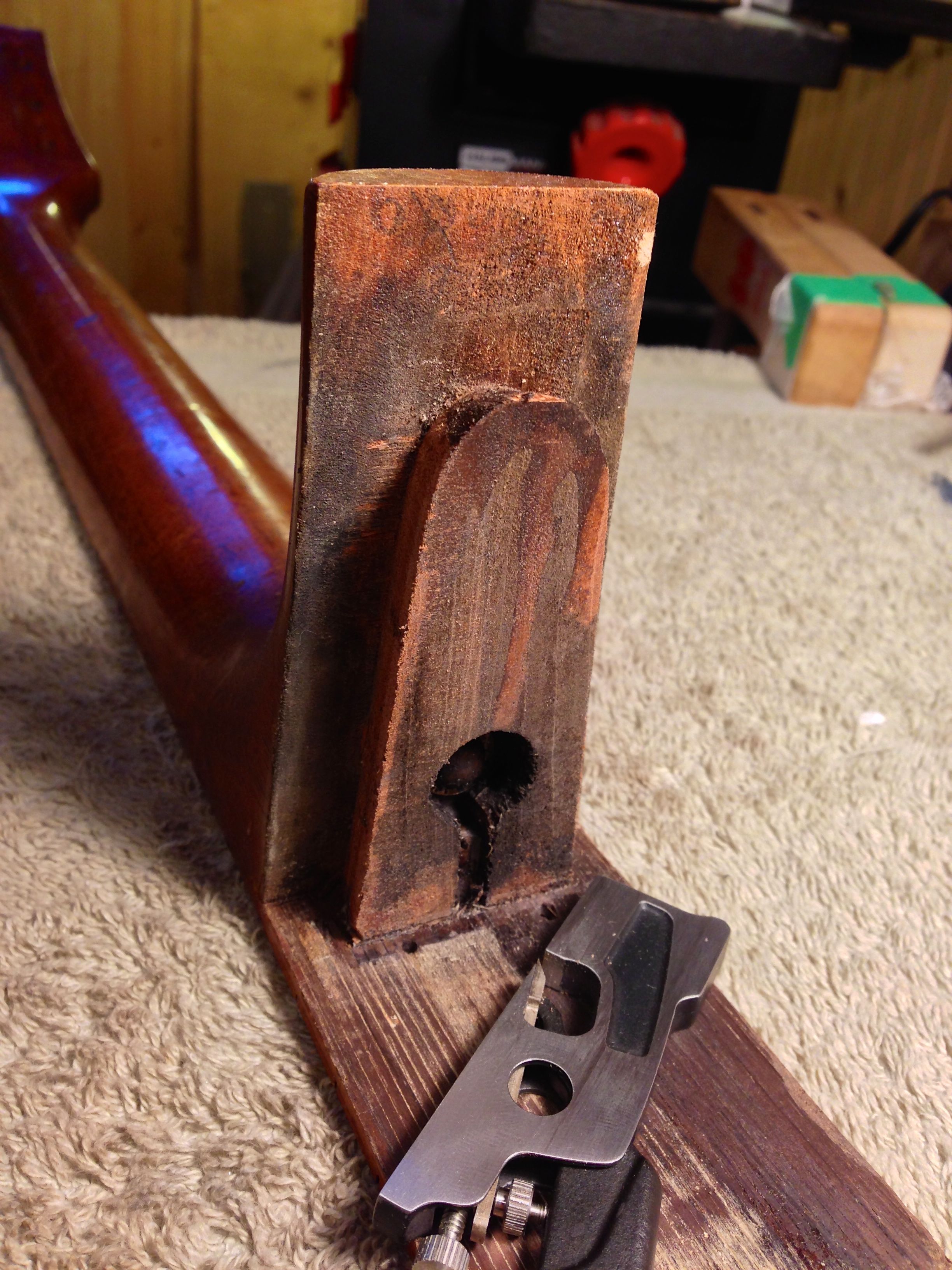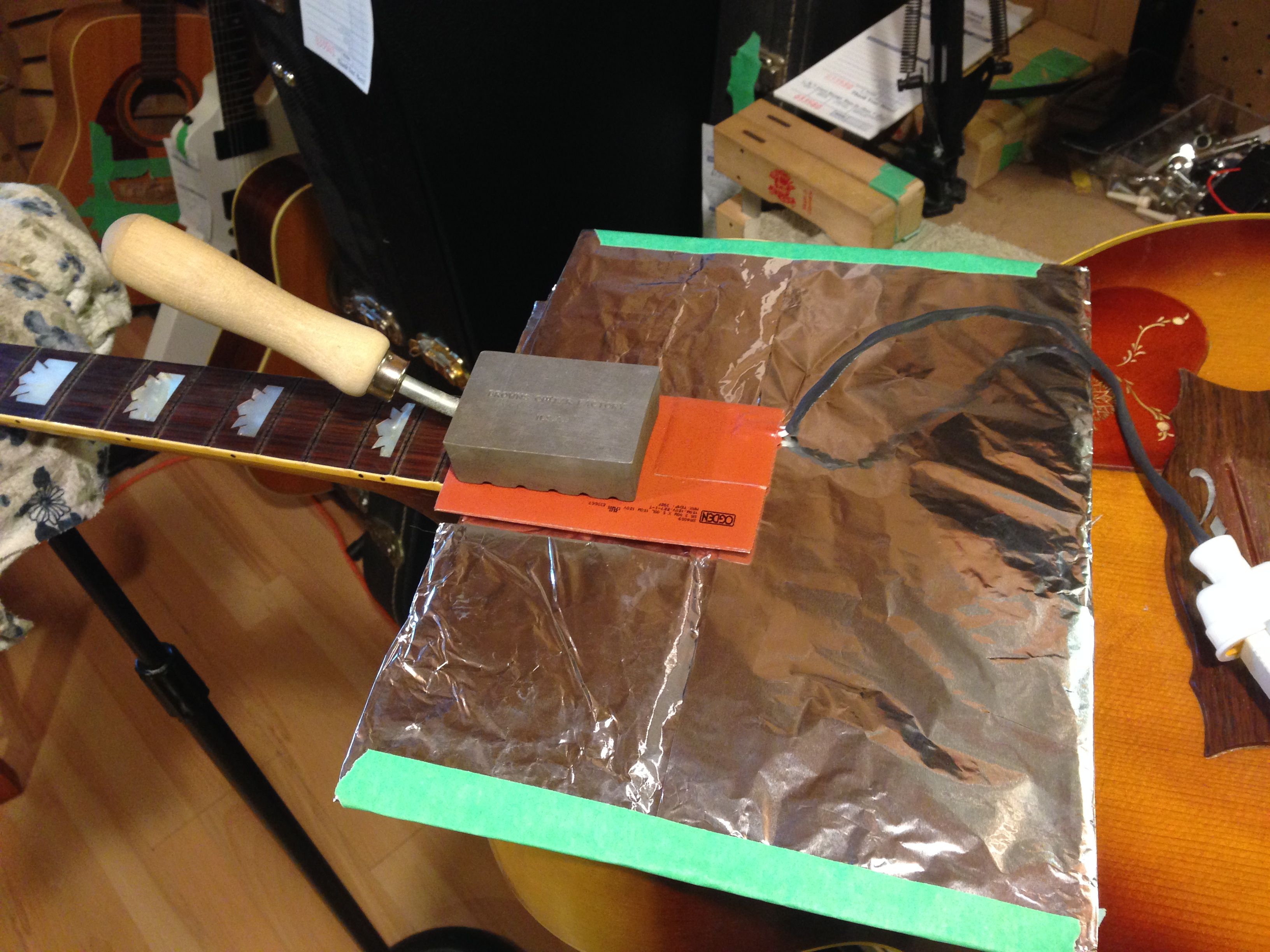Eventually, you run out of options, and you need to have the angle of the neck corrected, this is called a neck reset.  Different brands make their guitars in different ways, and some are easier to reset than others. In modern days, companies like Taylor guitars have a precisely machined neck joint than held together with three bolts, and its angle can be corrected by replacing the two laser machined shims with a new set. Some companies, like the Godin line of acoustics, know under the Norman, Simon & Patrick, Art & Luthiery and Seagull brand, are bolted onto the body, while the tongue of the fingerboard is glued to the top. The traditional way of joining a neck to an acoustic body is a dovetail joint, which I will discuss further later in the article. In the vast majority of cases, neck resets are only performed in order to correct an other incorrigible high action, but this also affects the tone of the guitar, and I am sometimes asked to reset a guitar neck for tonal reasons. The picture on the left shows you a mid '60's Gibson J-45 getting its neck steamed off.
Different brands make their guitars in different ways, and some are easier to reset than others. In modern days, companies like Taylor guitars have a precisely machined neck joint than held together with three bolts, and its angle can be corrected by replacing the two laser machined shims with a new set. Some companies, like the Godin line of acoustics, know under the Norman, Simon & Patrick, Art & Luthiery and Seagull brand, are bolted onto the body, while the tongue of the fingerboard is glued to the top. The traditional way of joining a neck to an acoustic body is a dovetail joint, which I will discuss further later in the article. In the vast majority of cases, neck resets are only performed in order to correct an other incorrigible high action, but this also affects the tone of the guitar, and I am sometimes asked to reset a guitar neck for tonal reasons. The picture on the left shows you a mid '60's Gibson J-45 getting its neck steamed off.
By increasing the angle of the neck, the saddle has to rise higher and higher above the top of the guitar in order to allow the strings to clear the frets and the guitar to be playable. As the saddle rises, the load being transmitted to the top by the string increases. The down bearing pressure on the top increases between the bridge and the sound hole, and the up bearing pressure increases between the bridge and the lower bout. It’s a lot like tightening the head on a drum, it’s just not as easily done. This is where the balancing act begins. If the neck angle is to shallow, and the saddle very low, and the bridge even sanded down, there is very little tension on the top, and the guitar will be quiet and weak. To much angle, and the top will “choked” under the string tension, unable to actually resonate, and it will physically distort very quickly. The picture on the right is that of a 2004 Martin D28-12 that I was comissioned to "over set", because the owner wanted that small shop luthier volume and definition added.
the strings to clear the frets and the guitar to be playable. As the saddle rises, the load being transmitted to the top by the string increases. The down bearing pressure on the top increases between the bridge and the sound hole, and the up bearing pressure increases between the bridge and the lower bout. It’s a lot like tightening the head on a drum, it’s just not as easily done. This is where the balancing act begins. If the neck angle is to shallow, and the saddle very low, and the bridge even sanded down, there is very little tension on the top, and the guitar will be quiet and weak. To much angle, and the top will “choked” under the string tension, unable to actually resonate, and it will physically distort very quickly. The picture on the right is that of a 2004 Martin D28-12 that I was comissioned to "over set", because the owner wanted that small shop luthier volume and definition added.
The trick is to find the sweet spot in between the two extremes, and this sweet spot is not where factory guitars are set. Factory guitars are now a little under set, in order to reduce the speed with which a reset will be needed, and to reduce warranty work. Luthier built and re-built guitars, like mine, Collings, Bourgeois, Hoffman, Goodall, and many more, are “over set” compared to the factory standards, which is why they sound so much louder and livelier.
The Dovetail:
 The traditional way of joining an acoustic guitar neck to its body is with a dovetail join, and it’s a fairly straight forward join to fabricate, but the most complex to deconstruct and adjust. Most of the big names in the acoustic guitar industry still use this construction method. Companies like Martin, Gibson, Larrivée, Guild, Fender and Collings, just to name a few, follow the dovetail tradition, and many small shop builders still cling on to this joinery method. The image on the left shows you the dovetail of a 1957 Gibson J-45 being cleaned up for a reset. A proper dovetail joint is what you would call a “self locking joint”. This means that it’s shape causes the two pieces being joined together to pull towards one another. A freshly cut dovetail joint is so strong that you can string up the guitar without glueing the neck in, which is also very handy if you want to see if you’ve done a good job.
The traditional way of joining an acoustic guitar neck to its body is with a dovetail join, and it’s a fairly straight forward join to fabricate, but the most complex to deconstruct and adjust. Most of the big names in the acoustic guitar industry still use this construction method. Companies like Martin, Gibson, Larrivée, Guild, Fender and Collings, just to name a few, follow the dovetail tradition, and many small shop builders still cling on to this joinery method. The image on the left shows you the dovetail of a 1957 Gibson J-45 being cleaned up for a reset. A proper dovetail joint is what you would call a “self locking joint”. This means that it’s shape causes the two pieces being joined together to pull towards one another. A freshly cut dovetail joint is so strong that you can string up the guitar without glueing the neck in, which is also very handy if you want to see if you’ve done a good job.
The Glues:
Another strong tradition is the type of glue used to affix the neck, and fingerboard tongue, to the body. I can’t tell you with absolute certainty what each company uses today, but vintage acoustics, which are the ones I operate on, are almost always assembled with hide glue, which is an animal glue created by the prolonged boiling of animal connective tissues, in this case: hides. This type of adhesive has been used for thousands of years. Their use is so ancient, that we have to go behind recorded history and inspect Neanderthal paintings, which were protected from moisture by horse teeth glues. So, we’re looking at about 6000 years of history, so this really isn’t new. And, just in case you were wondering, yes, it doesn’t smell very good.
Originally, animal glues were used because there simply wasn’t any other option when it came to joining two pieces of wood. Today, two types of glues are used in the fabrication of high end instruments. The first is the aforementioned hide glue, and the second is the modern PVA glues, also known as Polyvinyl Acetate. PVA is a thermoplastic with the formula (C4H6O2)n. The public know PVA glue and the good old white or yellow wood glue that you see in hardware stores.
Each type of glue has it’s pro’s and cons. The main advantage of hide glue is that it makes joints that are easily taken  apart. Only a little heat and moisture is needed to loosen a dovetail joint that’s assembled with this type of adhesive. Old Martin guitars are the easiest to disassemble because the necks and bodes are finished separately and the dovetails and fingerboard tongue are joined with hide glue. A typical Martin disassembly only takes about 45 minutes, including the time it takes to setup the tools. The picture on the right shows you my setup for loosening the tongue of the fingerboard on a 1960 Gibson J-200. There are two main disadvantages to hide glue. The first is a very short working time. The glue has to be kept hot, and it’s to dry to be used as glue after only 60 to 120 seconds, so you have to work really fast. The other down side is that it a very poor cohesive, meaning that it’s very week if the joint isn’t flawless. If you see a black line where your joint is with hide glue, odds are you can snap it open with your fingers, so you have to be very good at joinery to use it.
apart. Only a little heat and moisture is needed to loosen a dovetail joint that’s assembled with this type of adhesive. Old Martin guitars are the easiest to disassemble because the necks and bodes are finished separately and the dovetails and fingerboard tongue are joined with hide glue. A typical Martin disassembly only takes about 45 minutes, including the time it takes to setup the tools. The picture on the right shows you my setup for loosening the tongue of the fingerboard on a 1960 Gibson J-200. There are two main disadvantages to hide glue. The first is a very short working time. The glue has to be kept hot, and it’s to dry to be used as glue after only 60 to 120 seconds, so you have to work really fast. The other down side is that it a very poor cohesive, meaning that it’s very week if the joint isn’t flawless. If you see a black line where your joint is with hide glue, odds are you can snap it open with your fingers, so you have to be very good at joinery to use it.
As for PVA, the main reason to use it is it’s much higher cohesive factor, shelf life and open time. You have a good 10 minutes to get things done with PVA, and you don’t need to keep it, and the work pieces hot while working. It’s strong cohesive factor makes it ideal for structural repairs where the joint is less than perfect, like a broken headstock, or a loose brace that’s in to awkward a position inside the guitar to get the joint nice and clean. It’s easily cleaned up with water when still wet, and can still be cleaned with acetic acid when dry, as long as you use something like Trisodium Phosphate (Na3PO4) to neutralize the acid when you’re done. When used on a dovetail neck joint though, it does make removal much harder, since it needs a lot more heat and moisture in order to loosen the glue. It can absolutely be done, it’s just a lot harder. Guild guitars are at the opposite end, compared to Martin guitars, they’re first glued together with PVA, fingerboard tongue, dovetail and heel, and then finished, so they really aren’t that interested in the idea of coming apart.

